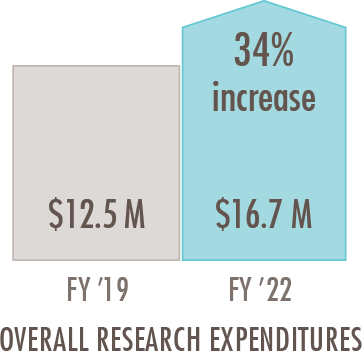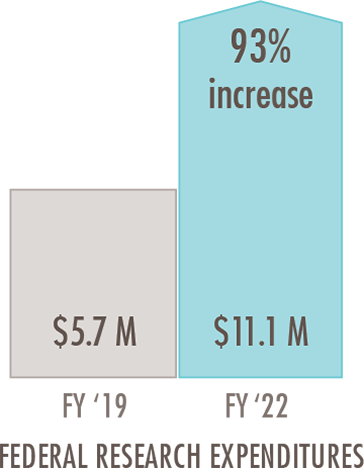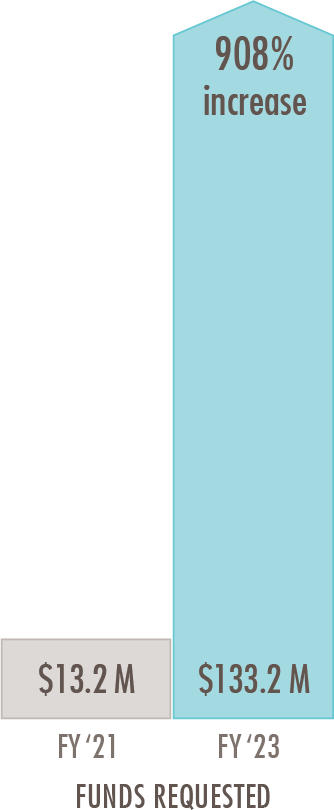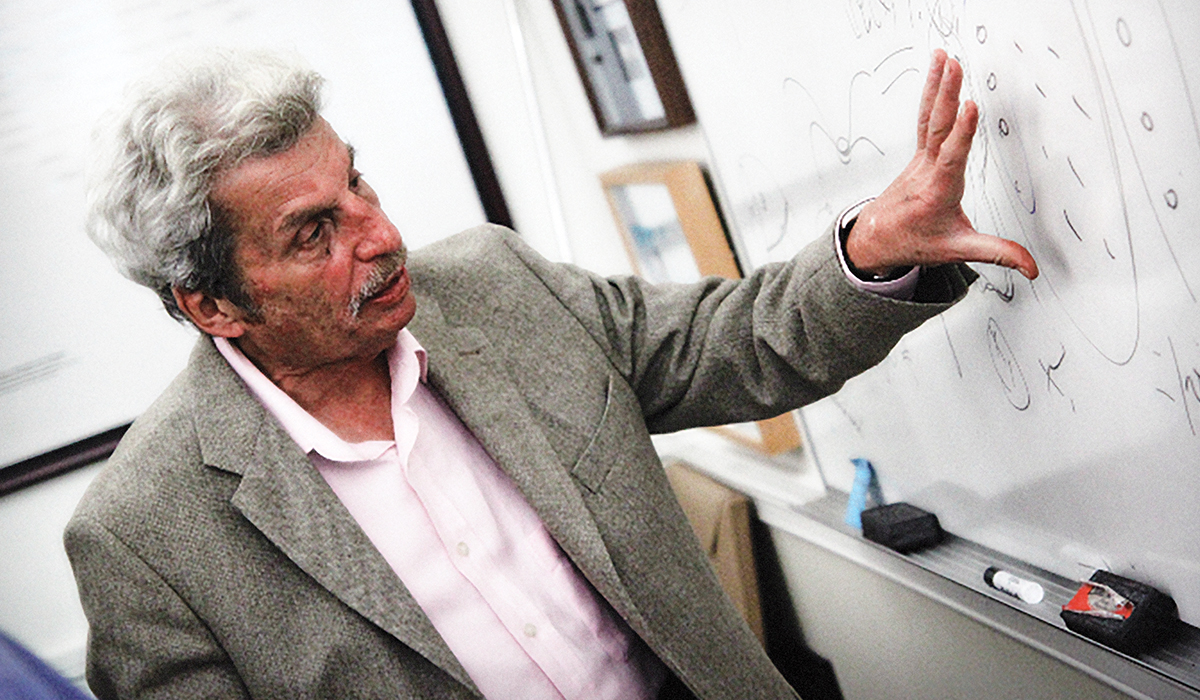What Are the Signs of a University on the Rise?
By Ben Brazil and Rachel Morrison



A commitment to supporting groundbreaking research with impact is propelling Chapman’s momentum.
Martina Nieswandt, Ph.D., vice president for research and graduate education
“The momentum will take us to become one of the very top institutions in the country,” Struppa, Ph.D, said at last spring’s State of the University address. “This is going to take between five and 15 years. This is not something that we’re going to see tomorrow. But we need to put in place all the elements we need to go there.”
Research With Purpose
A concerted investment in and support of Chapman’s research enterprise has yielded unprecedented results for research activity and impact across the university. Within the last two decades, the number of citations from the university has grown from 100 to more than 14,000.
Between 2021 and 2023, there was a 908% increase in funds requested, and overall research expenditures grew by 34% from $12.5 to $16.7 million. Specifically, federal research experienced a 93% increase.




“Chapman is committed to supporting a robust research infrastructure to push the boundaries of what is possible through our research, scholarship and creative ventures,” said Martina Nieswandt, vice president for Research and Graduate Education. “Chapman researchers are guided by a strong dedication to solving real-world problems with purposeful research to address local and international needs.”
Chapman researchers are working on some of the most significant issues the world faces. Professors Joshua Fisher and Gregory Goldsmith analyzed tree leaves and used satellite data to explore the breakdown of tropical rainforests due to climate change. The university’s Center for Demographics and Policy recently published a widely circulated report on a global housing crisis, shedding light on an issue that disproportionately impacts young people, minority groups and immigrants.
The university’s research efforts also highlight a uniquely interdisciplinary and collaborative enterprise. Through this approach, Chapman researchers are able to uncover innovative solutions to complex problems. Professor Cyril Rakovski, a data expert with Schmid College of Science and Technology, and other Chapman researchers worked with medical schools and other professors to produce one of the largest and most comprehensive Alzheimer’s treatment studies to date. They found that hundreds of thousands of people would significantly increase their lifespan with the combined usage of two existing medications. In another example of interdisciplinary collaboration, Professors Anuradha Prakash and John Miklavcic combined their food science and nutrition expertise, two disciplines that have tended to be siloed, to find that widely used processing methods may affect a nutritional component of dairy products that could be critical for development, healing and bone health.
Martina Nieswandt, Ph.D., vice president for research and graduate education
Further exemplifying a commitment to collaborative research and global impact, the university is also empowering junior-level faculty to pursue research with the launching of the Support of Open Access Research and Scholarship (SOARS) program, which provides financial support to faculty publishing their work in an open-access journal. The program provides up to $3,500 to cover the cost of publishing an open-access article. Supporting open-access research is a critical service to the public, as it makes research widely available without a subscription, removing financial barriers and promoting interdisciplinary collaboration.
“Many of the most pressing challenges of our time cannot be addressed adequately through a single discipline,” Nieswandt said. “Chapman addresses these complex issues with a collaborative spirit, combining expertise from multiple fields. By breaking down the barriers between disciplines, we unlock the potential for groundbreaking discoveries and transformative solutions.”
A “Quantum Leap” in Physics Research
Like so many supercharged particles, transformation defines the research at Chapman’s Institute for Quantum Studies.
This past spring, Yakir Aharonov, co-director of IQS and holder of the James J. Farley Professorship in Natural Philosophy, was elected as a member of the Royal Society, the United Kingdom’s national academy of sciences (read more on Pg. 16). Elected fellows, recognized for their invaluable contributions to science, are leaders in their fields and come from all parts of the world. They are elected for life through a peer review process based on excellence in science. Aharanov joins the ranks of Isaac Newton, Benjamin Franklin, Charles Darwin and Albert Einstein, among other luminaries.

Schmid College Professor Yakir Aharonov was recently honored for his invaluable contributions to science.
Aharonov is renowned for his contributions to the co-discovery of the Aharonov-Bohm Effect, a quantum-mechanical phenomenon in which an electrically charged particle is affected by an electromagnetic potential.
“Yakir’s discoveries, going back to the Aharonov-Bohm Effect of 1959, and up to the more recent introduction of the concept of weak measurements and weak values, lay the foundation for exciting and groundbreaking innovations in the field of physics,” said Struppa. “Yakir continues to be an extremely active and creative scientist, and I’m sure we will see many more brilliant contributions from him in the years to come.” Further enhancing the quantum physics research at Chapman, the university will establish the Southern California Quantum Foundations Hub with a recent Templeton Foundation grant. This unique collaboration includes theoretical physicists, experimental physicists and philosophers who will apply the methods of their respective disciplines to more deeply understand the nature of reality.
“We plan to work on topics that will expand our understanding of the quantum state and in what sense it is reflective of external reality and/or our degree of knowledge,” said Andrew Jordan, professor of physics and the co-director of IQS. “The nature of time is also fundamental to integrating past and future events into a new theory we are developing of continuously monitored quantum systems.”
This Hub will focus on key topics in quantum foundations research and serve as the primary center of excellence in the United States for the field. Topics in quantum foundations, as well as breaking discoveries and insights, will also be taught to the wider scientific community and public through regular seminars, annual conferences and public lectures.
“The John Templeton Foundation grant establishing the Southern California Quantum Foundations Hub at Chapman University is a testament to the game-changing impact of our faculty’s interdisciplinary research–past and future,” Struppa said. “With this grant, our university will become the primary center of excellence in the U.S. for the field of quantum foundations, an emerging field ripe with potential for major scientific discoveries and a greater understanding of the nature of reality.”
This winter, the IQS and the university’s Advanced Physics Laboratory (APL) will get a new home at Chapman’s fully renovated historic Killefer building. The facility will focus on frontiers of quantum materials science research using advanced equipment, acquired with support funding from the Office of Naval Research.
A primary stated goal of the APL is to achieve room-temperature superconductivity, which would enable the transmission of electrical energy without any resistance at ambient conditions. The practical applications of such a technology include ultra-efficient computing systems, quantum information processing and electricity grids, all of which would indelibly transform society.
“With this move to Chapman’s main campus, our progress will continue to accelerate,” says Armen Gulian, senior research scientist and director of the APL. “Chapman is beginning to compete with the giants in physics.”
Media Contacts
Strategic Marketing and Communications
1 University Drive
Orange, CA 92866
Contact Us
Newsroom Site
Your Header Sidebar area is currently empty. Hurry up and add some widgets.
